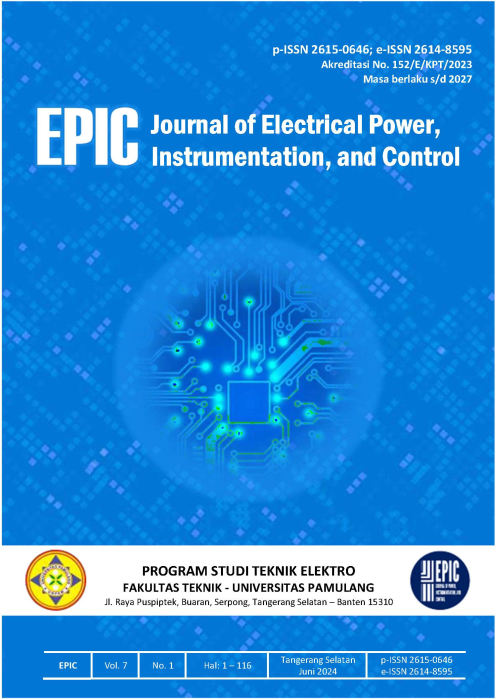Analisis Pengaruh Perubahan Arus Eksitasi Terhadap Tegangan Keluaran dan Daya Reaktif di PLTG Gilimanuk
DOI:
https://doi.org/10.32493/epic.v7i1.38427Keywords:
Generator, excitation current, reactive power, cosphiAbstract
One of the most important components of a power plant is the generator, the change in a load will affect the voltage of the generator. The excitation system also has the task of monitoring and controlling the output voltage of the generator, therefore the generator must be able to generate electrical power in accordance with the amount of load given. The purpose is to compare the results of EDS measurements with the results of the calculations obtained, which will be analyzed with the aim of minimizing the occurrence of interference with excitation and reactive power in the generator. The analysis shows that the largest excitation current is found at 21:00 setting the excitation current by 868 A, the resulting voltage is 16.0 kV, while from the calculation results of 15.8 kV, from the comparison of measurements with calculations having 0.2 kV or 200 V. At 09:00 with an excitation current of 778 A, with an anchor current of 7.9 kA the reactive power produced is 25 MVAR, while in the calculation of the reactive power obtained at 24.6 MVAR, in the measurement with the calculation has a difference of 0.4 MVAR or 400 kVAR. At 22:00 it gets a reactive power of 15 MVAR so that it produces a power factor of 0.96, while in the cosphi calculation which is obtained at 0.95. It can be concluded that the greater the excitation current, the generator output voltage will be large, if the excitation current is large, the reactive power will also be large, if the reactive power is large, it will cause cosphi to decrease because the reactive power is inversely proportional to cosphi which will later cause power losses.
References
Azis, H., Pawenary, P., & Sitorus, M. T. B. (2019). Simulasi Pemodelan Sistem Eksitasi Statis pada Generator Sinkron terhadap Perubahan Beban. Energi & Kelistrikan, 11(2), 46–54. https://doi.org/10.33322/energi.v11i2.483
Burhanuddin, B., Haddin, M., & Nugroho, A. A. (2022). Pengaruh Perubahan Temperatur Terhadap Daya Output Generator PLTG 1.1 Blok I Tambak Lorok Semarang. Cyclotron, 5(01), 29–34. https://103.114.35.30/index.php/ cyclotron/article/view/9507
Perawati, P. (2020). Karakteristik Generator Sinkron Yang Berbeban Berat Dan Tidak Konstan. Jurnal Ampere, 2(2), 115. https://doi.org/10.31851/ ampere.v2i2.1775
Puspitaputri, G. Y., Priananda, C. W., & Syahbana, D. F. (2021). Automatic Voltage Regulator (AVR) Generator dengan Mikrokontroler Menggunakan Metode Hill Climbing. Jurnal Teknik ITS, 10(2), 171–176. https://doi.org/10.12962/j23373539.v10i2.67421
Putra, S. A., & Santoso, D. B. (2022). Analisis Pengaruh Arus Eksitasi Terhadap Daya Reaktif Generator Sinkron Unit 3 Plta Ubrug. Jurnal DISPROTEK, 13(2), 113–122. https://doi.org/10.34001/jdpt.v13i2.3160
Farhan, M. (2021). Simulasi Pemodelan Sistem Eksitasi Statis pada Generator Sinkron terhadap Perubahan Beban. JURNAL SIMETRIK, 11(1), 398. https://doi.org/10.31959/js.v11i1.653
Ramadhan, Zondra, E., & Halilintar, M. P. (2021). Analisis Eksitasi Generator Unit 3 Pembangkit Listrik Tenaga Gas ( PLTG ) Teluk Lembu PT . PLN ( Persero ) Sektor Pembangkitan Pekanbaru. Jurnal Sains, Energi, Teknologi & Industri, 6(1), 32–38. https://doi.org/10.31849/sainetin.v6i1.7318
Harahap, M. (2021). Pengaruh Perubahan Variasi Eksitasi Tegangan Terhadap Daya Reaktif Pada Generator. Teknik Elektro, 3(2), 71–76.
Manangka, R., Mangindaan, G. C., & Tumaliang, H. (2022). Analisa Pengaruh Perubahan Beban terhadap Efisiensi Generator Sinkron 3 Fasa di PLTP Lahendong Unit 3. Jurnal Teknik Elektro Universitas Sam Ratulang, 1–7.
Shintawaty, L. (2013). Peranan Daya Reaktif Pada Sistem Kelistrikan. Jurnal Desiminasi Teknologi, 1(2), 109–128.
Downloads
Published
How to Cite
Issue
Section
License
Copyright (c) 2024 EPIC Journal of Electrical Power Instrumentation and Control

This work is licensed under a Creative Commons Attribution-NonCommercial-ShareAlike 4.0 International License.
This journal provides immediate open access to its content on the principle that making research freely available to the public, supporting a greater global exchange of knowledge.

Journal of Electrical Power, Instrumentation and Control adhere to Attribution-ShareAlike 4.0 International license.
Journal of Electrical Power, Instrumentation and Control menganut lisensi Atribusi-BerbagiSerupa 4.0 Internasional.



















